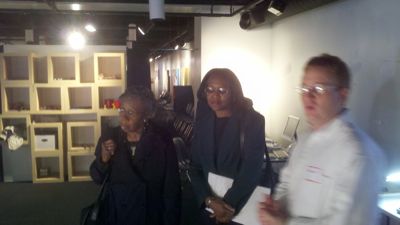On Saturday, October 22, eight undergraduate students and fifteen graduate students digitized dozens of documents at Love’s Jazz and Art Center in North Omaha as part of our third major History Harvest in Nebraska. Some remarkable stories, documents, and objects came forward as people from the community brought out their history to share with scholars, teachers, and students. The scene was celebratory but earnest, enthusiastic but expectant. And a sense of revival, renewal, purpose, community, and honesty greeted visitors.
KVNO aired a radio feature on Monday during drive time–“History Harvest Finds Treasures in North Omaha.”
Two stories, in particular, struck me personally and professionally as moving and significant. The first is about U.S.C.T. graves, one unmarked, in the Laurel Hill Cemetery in Omaha. Local researcher Creolla Woodall has been working to restore the graves, provide appropriate markers, and bring this history back to public recognition. One soldier, James Adams, was free in 1860, living in Harford County, Maryland, near Baltimore when he enlisted in the 4th U.S.C.T. The 4th U.S.C.T. Co. E was photographed at Fort Lincoln in northwestern Washington, D.C., at some point probably in early 1863 before taking the field in Virginia later that year. Fort Lincoln was located on the Washington Branch of the Baltimore & Ohio Railroad. Adams was wounded in the war, losing his arm at the Battle of Chaffin’s Farm, Virginia. Later, sometime in the 1880s it appears, Adams moved to Omaha, Nebraska.
His U.S.C.T. counterpart buried at Laurel Hill, Edward Jones, was born in Virginia, most likely into slavery. At some point in 1864, he made his way to Marietta, Georgia, and enlisted in the 13th U.S.C.T., guarded railroads, and after the war made his way to Omaha, Nebraska. The graves of U.S.C.T. soldiers too often go unrecognized and the service and histories of these men unexamined. They tell us much about the wider patterns in the war–two black men, one enslaved, one free, both enlist, both fight, one is wounded, both migrate after the war, eventually to Omaha, Nebraska. They build businesses. They serve their communities. They have deep individual histories we are only able to glimpse though the broader national significance of their stories.
Warren Taylor brought two special, and astonishingly moving, items from his family’s history to the History Harvest. His 1841 U.S. penny was carried by his enslaved great grandmother as was a silver drinking cup. Holding these items, looking at them up close, brings slavery more clearly into focus, into real lived experiences. Both were digitized to be shared with students and teachers across Nebraska and the nation. The stories behind these objects and documents will be made available on the History Harvest web site in coming weeks and months.
There is no question that digitizing history at the community level raises matters of concern, especially about whether history is being expropriated and true partnership can exist. The students worked with churches, businesses, community organizations, and schools. They participated in the Making Invisible Histories Visible project with Omaha Public Schools, and worked with the Great Plains Black History Museum. Indeed, the Harvest is meant to be inclusive and open, as well as to enable a richer, more complete history for our communities.
On Saturday, as people came to talk about their community, their history, and their families, the conversations were rich with significance. Every family has its own history, but we often forget how much our family history is part of the national story. At this History Harvest we had the chance to see this connection and to talk and think about a more inclusive and public history.
